-

Image of a black Imperial Typewriter. Circular keys, part of the logo is worn away.
-
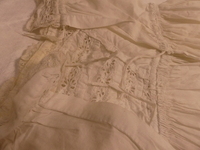
This white cotton christening gown was originally worn by Professor Jack Erskine, a Canterbury College alumni and staff member in the Mathematics Department, who worked closely with Ernest Rutherford.
The christening down is modestly decorated with lace, whitework embroidery, and broderie anglaise, a type of needlework popular in England during the late 19th Century. Lace trims the collar of the gown, while the bodice and sleeves are decorated with the whitework embroidery and broderie anglaise.
Like most christening gowns from the 1870s, this gown has a long skirt, which would drape elegantly from the baby's body. The skirt is also decorated. The top section of the skirt begins with a series of cartridge pleats but is otherwise plain. The lower half is horizontally pleated every few centimetres. Beneath the pleating is a long trim of broderie anglaise in oval patterns.
The back of the gown is open, allowing the baby to be clothed easily, and is secured with ties.
-

This frame holds the Debating Scroll, an award for the Canterbury College Dialectic Society annual debating competition, held from 1910 until 1935. The highly decorative calligraphy recording each winner's name has been hand-printed on what appears to be vellum.
A competition winner was not awarded in 1914, 1915, 1916, 1918, 1922, and 1929. Notably, the first four of those dates were during World War One.
AC Brassington, who won the award in 1923, may be Alan Brassington, a lawyer who specialised in constitutional law. He is credited as the founder and first secretary of the Canterbury College Law Students' Society 1923, and later lectured in constitutional history and law, political science, and administrative and international law 1931-1951.
-

A pressuring vessel, likely built in-house using spare parts from other machines, in the Chemistry Department at the University of Canterbury.
This instrument was used for Dr Robin Mann’s PhD project in the late 1950s to early 1960s. Dr Mann completed three degrees in Chemistry at the then Canterbury College of the University of New Zealand – BSc (1957), MSc (Hons) (1959) and PhD (1962), and worked as a part-time lecturer before embarking on a distinguished career in industry and management.
In 2001, Dr Mann was co-opted to the University Council and shortly afterwards was appointed Pro-Chancellor. He was appointed Chancellor in 2003, and stepped down from Council at the end of May, 2019. Dr Mann continued serving the University, acting as both Chair and Deputy Chair of the UC Foundation.
-

This electrostatic generator, known as a Wimshurst machine, was named after the inventor James Wimshurst. A version of this machine, and a similar machine known as a Voss machine, were used in the Physics Department at Canterbury College while the College was still based at its original site (now The Arts Centre Te Matatiki Toi Ora) in Christchurch’s central city. Physics was one of the first subjects taught at Canterbury College, when its first professor, A.W. Bickerton, began teaching in 1874.
This distinctive machine was built in-house. The rotating plates were found in storage at the Arts centre by Dr John Campbell, who then organised for the Department workshop to make one according to original plans in 1979. The age of the rotating plates is not yet established.
-
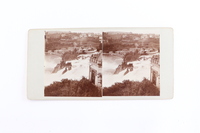
Collection of stereograph cards or photographs, held in eight boxes. The cards feature images of Europe (Germany, North Italy, France, England, Scotland, Wales). Possibly made and used by architect and lecturer Samuel Hurst Seager for teaching.
-
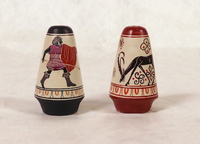
This set of classically themed salt and pepper shakers were once owned by Miss Marion Steven, founder of the James Logie Memorial Collection. The ceramic shakers are cone-shaped, with six holes on the top and a clear plastic stopper at the bottom.
-

Microscope assembled by Charles Ethelbert Foweraker (1886-1964) while he was a student at Canterbury College. Hand-carved wooden stand with metal scope, probably purchased and assembled.
The main section of the stand is made of a vanished light brown wood, while the feet and focusing knob have also been made of wood but painted black. The majority of the scope has also been painted black, but the objective lens has been left to show the shiny brass. The focusing plate, stage clips have been painted black, but the substage mirror holder is brass.
-
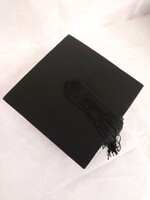
A black trencher, or mortar board, with tassel. Owned by Professor James Hight. Either made by or supplied by J Ballantyne and Co.
-
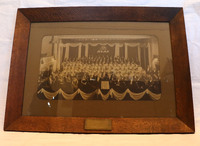
Framed photograph, group portrait of the Royal Christchurch Musical Society. Engraved silver plaque. Presented to Dr John Christopher Bradshaw in 1920.
-
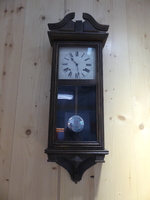
Wall-mounted clock. Known as Bickerton’s Clock, as it was acquired by Professor A. W. Bickerton, Canterbury College’s first professor of chemistry. Bickerton acquired the clock in the 1870s and mounted it in the Chemistry Department’s building. It has stayed in the Chemistry Department’s possession ever since.
-

Green metal-framed bicycle with leather seat, rubber handle grips and black splash guards. This bicycle was originally used at the University of Canterbury Cass Field Station in the early 1900s by visiting academics, staff and students. During the 1980s, it was saved from the dump at Cass by a member of staff who recognised it from one of the photographs of the field station taken by Charles Foweraker in 1914.
-

An automatic calculator or adding machine used by the Department of Chemistry at Canterbury College (now the University of Canterbury). This particular model is electric, and would have been used in the Chemistry laboratories by staff and students.
-
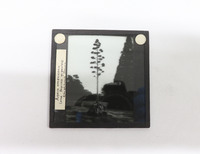
A collection of b&w glass plate lantern slides stored in a metal drawer, featuring images of the Cass region and surrounding landscape, as well as trees, plants and scientific drawings. . The slides may have belonged to Charles Foweraker, former Head of the School of Forestry and lecturer in Biology at the University of Canterbury.
-
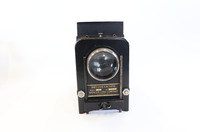
A Delineascope - Model O/J, Number 2379 Lantern Slide Projector, also known as a Magic Lantern Projector. It was used for teaching by the Department of Art History at Canterbury College. The projector comes with a slide holder and a carry case.
-
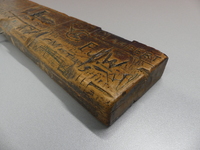
Fragment of a desk from a lecture theatre at the original site of Canterbury College in Christchurch. The fragment has been covered on both sides with names of students, most dating from 1890-1920.
-
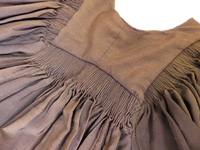
A black academic day gown, which would have been worn by a Canterbury College staff member while teaching at the original College site. Found in the Department of Classics, the gown may be associated with Miss Marion Steven.
-
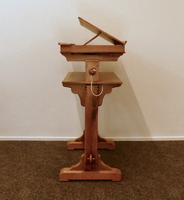
This wooden lectern, possibly carved from rimu, would have once been the central focus in a lecture theatre at Canterbury College. It has a top which can be titled towards the user, a niche for an inkwell and pen, and an adjustable height mechanism.
-
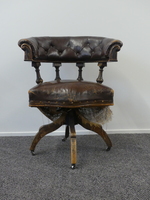
Wooden club chair with curved seat back and arms, brown studded leather upholstery, height adjustment mechanism and legs with castors. It is believed that this chair once belonged to Professor John Macmillan Brown, one of the foundation professors at Canterbury College.
-
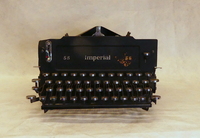
A British Imperial 55 model typewriter key set featuring the Greek alphabet. This set of keys can be swapped in and out of a typewriter frame, allowing the user to change languages.
This typewriter is believed to have been used by Miss Marion Steven, who began lecturing in the Department in 1944, when the University was known as Canterbury University College. Before computers were widely available, typewriters were used for daily administration work and typing up exercises for students.
-
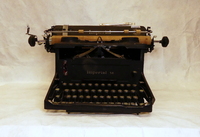
A British Imperial 58 model typewriter from the Department of Classics at the University of Canterbury. This typewriter is believed to have been used by Miss Marion Steven, who began lecturing in the Department in 1944, when the University was known as Canterbury University College. Before computers were widely available, typewriters were used for daily administration work and typing up exercises for students.
-
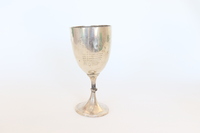
A silver trophy cup belonging to the Canterbury College Boxing Club, who awarded it to victorious members between 1921 and 1927. The names of each of the winners is engraved on the cup, and adjacent to the inscription are the silver marks.






















